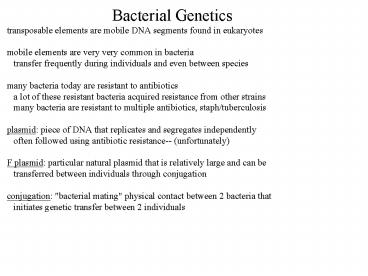Bacterial Genetics - PowerPoint PPT Presentation
1 / 17
Title:
Bacterial Genetics
Description:
lysis: splitting open of the bacteria (ie. to release phage) ... 1 bacteria lyses, releasing 100's of phage, they infect nearby bacteria, etc ... – PowerPoint PPT presentation
Number of Views:339
Avg rating:3.0/5.0
Title: Bacterial Genetics
1
Bacterial Genetics
transposable elements are mobile DNA segments
found in eukaryotes mobile elements are very
very common in bacteria transfer frequently
during individuals and even between species many
bacteria today are resistant to antibiotics a
lot of these resistant bacteria acquired
resistance from other strains many bacteria
are resistant to multiple antibiotics,
staph/tuberculosis plasmid piece of DNA that
replicates and segregates independently often
followed using antibiotic resistance--
(unfortunately) F plasmid particular natural
plasmid that is relatively large and can be
transferred between individuals through
conjugation conjugation "bacterial mating"
physical contact between 2 bacteria that
initiates genetic transfer between 2 individuals
2
Bacterial Genetics
3
Bacterial Genetics
4
Bacterial Genetics
conjugative plasmids plasmids that carry genes
coding for proteins responsible for forming a
pilus pilus protein/lipid tube connecting 2
bacteria F cells are DNA donors-- give the F
factor plasmid to the other bacteria F- cells are
DNA acceptors-- don't give DNA to the F
bacterial strain F-factors transfer through
rolling circle replication
5
Bacterial Genetics
cointegrate fusion of two plasmids mediated by
homologous recombination between
transposons cointegrate formation requires the
same direct repeat to be in the plasmid and
the bacterial genome heterologous recombination
between direct repeats causes the insertion of
the plasmid into the genomic DNA plasmid can
be excised again from the genome using the
direct repeats episome DNA sequence that can
exist either in an integrated or an independent
form
6
Bacterial Genetics
Cre recombinase site specific recombinase that
recognizes a 34 bp loxP DNA sequence that has
internal symmetry (general characteristic)
recognition site gets duplicated at both ends of
the inserted sequence
7
Bacterial Genetics
8
Bacterial Genetics
cointegrate conjugation results in the net
transfer of only genomic DNA from one bacteria
to another-- note that it is only a partial
transfer
9
Bacteriophage Genetics
10
Bacteriophage Genetics
by looking for genes allowing survival, you can
find recombined genes cotransduction genes
found nearby on chromosome are found in same
phage cotransduction is common for a
generalized transducing phage (able to pick
up random short pieces of DNA)
11
Bacteriophage Genetics
frequency of cotransduction will tell you how
close two genes are on the chromosome high
frequency very close together low frequency
somewhat farther apart no frequency too far
apart to fit into a phage-- approx 100 kb use
different terminology when dealing with phage and
bacteria lytic phase reproductive cycle of the
phage-- infects bacteria, takes over, makes
lots of copies of itself, cell gets worn out and
dies lysis splitting open of the bacteria (ie.
to release phage) lysogenic phase 'resting
phase'-- infects the bacteria, integrates into
the bacterial genome via recombination, sits
around and divides with the bacteria-- does
NOT produce more infectious particles
12
Bacteriophage Genetics
when phage are in the lytic phase of their life
cycle, they form plaques 1 bacteria lyses,
releasing 100's of phage, they infect nearby
bacteria, etc
each plaque represents 1 original phage infecting
a bacteria
13
Bacteriophage Genetics
2 phage can infect the same bacteria-- if they're
generally the same kind of phage (ie. both l
phage), they can form recombinants between
different mutant strains through homologous
recombination ie. r large plaques, r- small
plaques (use r r- because no dominance!)
h turbid (opaque) plaques, h- clear if wild
type were r-h and rh- then rh and r-h- are
recombinants can figure out recombination
frequency by counting each plaque (parental
or recombinant) frequency recombinant / total
14
Bacteriophage Genetics
lysogenic phase 'resting phase'-- infects the
bacteria, integrates into the bacterial genome
via recombination, sits around and divides with
the bacteria-- does NOT produce more
infectious particles prophage DNA for the phage
when it is incorporated into the bacterial
genome lysogen bacteria containing prophage
DNA environmental signals (like an abundance of
food) or another signal can convert a lysogen
into an infected cell that reproduces phage
lytically lots of food suggests lots of
bacteria (to be infected by the phage)
15
Bacteriophage Genetics
16
Bacteriophage Genetics
bacteriophage l is the best understood
bacteriophage the l genome is linear with
single stranded, complimentary DNA ends can
ligate together to form a circular DNA molecule
but is packaged into infectious particles as a
linear molecule approx. 50 kb in size, and like
bacterial operons have genes clustered
according to functions
17
Bacteriophage Genetics
head protein coat surrounding the DNA in an
infectious particle tail filamentous proteins
coming from the back of the head responsible
for recognizing the bacteria to infect (E.
coli) genes on the right are ordered according
to the time during the lytic cycle in which
they are required-- left first, right at the end
leftmost genes Q, S, and R are expressed from
the same RNA and are made at the same time as
the head and tail genes l integrates at a
particular site between the bacterial gal and bio
genes (prophage is always linked to these 2
genes) gene order of the prophage is not quite
the same as in the phage particles































